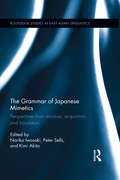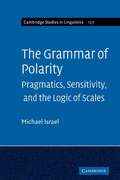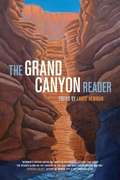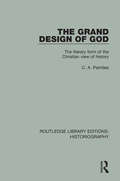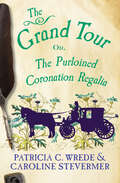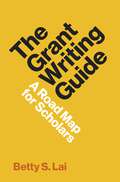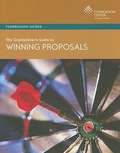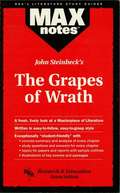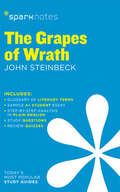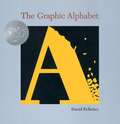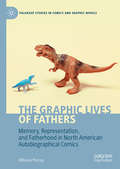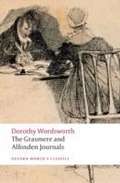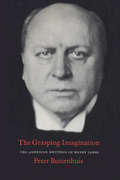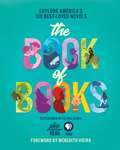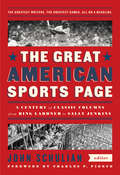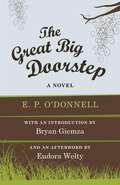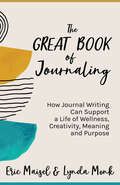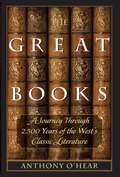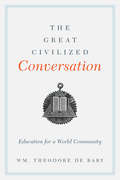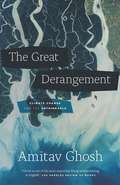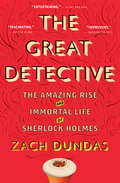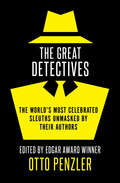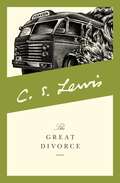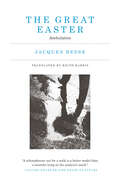- Table View
- List View
The Grammar of Japanese Mimetics: Perspectives from structure, acquisition, and translation (Routledge Studies in East Asian Linguistics)
by Noriko Iwasaki Peter Sells Kimi AkitaMimetic words, also known as ‘sound-symbolic words’, ‘ideophones’ or more popularly as ‘onomatopoeia’, constitute an important subset of the Japanese lexicon; we find them as well in the lexicons of other Asian languages and sub-Saharan African languages. Mimetics play a central role in Japanese grammar and feature in children’s early utterances. However, this class of words is not considered as important in English and other European languages. This book aims to bridge the gap between the extensive research on Japanese mimetics and its availability to an international audience, and also to provide a better understanding of grammatical and structural aspects of sound-symbolic words from a Japanese perspective. Through the accounts of mimetics from the perspectives of morpho-syntax, semantics, language development and translation of mimetic words, linguists and students alike would find this book particularly valuable.
The Grammar of Polarity
by Michael IsraelMany languages include constructions which are sensitive to the expression of polarity: that is, negative polarity items, which cannot occur in affirmative clauses, and positive polarity items, which cannot occur in negatives. The phenomenon of polarity sensitivity has been an important source of evidence for theories about the mental architecture of grammar over the last fifty years, and to many the oddly dysfunctional sensitivities of polarity items have seemed to support a view of grammar as an encapsulated mental module fundamentally unrelated to other aspects of human cognition or communicative behavior. This book draws on insights from cognitive/functional linguistics and formal semantics to argue that, on the contrary, the grammar of sensitivity is grounded in a very general human cognitive ability to form categories and draw inferences based on scalar alternatives, and in the ways this ability is deployed for rhetorical effects in ordinary interpersonal communication.
The Grand Canyon Reader
by Lance NewmanThis superb anthology brings together some of the most powerful and compelling writing about the Grand Canyon--stories, essays, and poems written across five centuries by people inhabiting, surviving, and attempting to understand what one explorer called the "Great Unknown." The Grand Canyon Reader includes traditional stories from native tribes, reports by explorers, journals by early tourists, and contemporary essays and stories by such beloved writers as John McPhee, Ann Zwinger, Edward Abbey, Terry Tempest Williams, Barry Lopez, Linda Hogan, and Craig Childs. Lively tales written by unschooled river runners, unabashedly popular fiction, and memoirs stand alongside finely crafted literary works to represent full range of human experience in this wild, daunting, and inspiring landscape.
The Grand Design of God: The Literary Form of the Christian View of History (Routledge Library Editions: Historiography)
by C. A. PatridesThis book, originally published in 1972, offers a stimulating account of the Christian tradition of historiography as it is reflected in works of literature and history. The discussion ranges from the pre-Christian The Iliad up to the 1970s. The author considers subjects such as the Mystery Plays in the medieval synthesis, the nature of the evidence provided by the Renaissance authors in England and the Continent, the contemporary world. The book examines the attitudes of historians and at the use historians have made of the Christian view of history.
The Grand Tour: Or, The Purloined Coronation Regalia (The Cecelia and Kate Novels #2)
by Patricia C. Wrede Caroline StevermerTwo young Regency ladies with special powers must save the monarchy: &“A satisfying blend of magic, mystery, humor, and romance&” (Booklist). Ocean voyages do not agree with wizards, and seasickness during the Channel crossing is the price Cecelia must pay for her budding magical skill. As her nausea ebbs, she is comforted by her new husband, James, and the knowledge that at long last they are on their honeymoon. In their company is Cecelia&’s cousin Kate, newly minted as the Marchioness of Schofield, and her husband, Thomas. The shared journey guarantees the two couples a happy start to married life, if they can survive the perils of the Continent. In Calais, a mysterious woman visits Cecelia with a package intended for Thomas&’s mother. Inside is an alabaster flask of noble manufacture, one of the royal artifacts that have been vanishing all over Europe as part of a magical plot against the French crown. This is no simple honeymoon: On their tour of Europe, Kate and Cecelia must save the monarchy from an emperor-in-exile named Napoleon. This ebook features illustrated biographies of Patricia C. Wrede and Caroline Stevermer including rare photos and never-before-seen documents from the authors&’ personal collections.
The Grant Writing Guide: A Road Map for Scholars (Skills for Scholars)
by Betty LaiA practical guide to effective grant writing for researchers at all stages of their academic careersGrant funding can be a major determinant of promotion and tenure at colleges and universities, yet many scholars receive no training in the crucial skill of grant writing. The Grant Writing Guide is an essential handbook for writing research grants, providing actionable strategies for professionals in every phase of their careers, from PhD students to seasoned researchers.This easy-to-use guide features writing samples, examples of how researchers use skills, helpful tips, and exercises. Drawing on interviews with scores of grant writers, program officers, researchers, administrators, and writers, it lays out best practices, common questions, and pitfalls to avoid. Betty Lai focuses on skills that are universal to all grant writers, not just specific skills for one type of grant or funder. She explains how to craft phenomenal pitches and align them with your values, structure timelines and drafts, communicate clearly in prose and images, solicit feedback to strengthen your proposals, and much more.Ideal for course use, The Grant Writing Guide is an indispensable road map to writing fundable grants. This incisive book walks you through every step along the way, from generating ideas to finding the right funder, determining which grants help you create the career you want, and writing in a way that excites reviewers and funders.
The Grantseeker's Guide to Winning Proposals
by Judith B. Margolin Elan K. DimaioPublished for development officers, nonprofit board members, fundraising consultants, and others in pursuit of grants from U.S. foundations, this guide provides real-world proposals that resulted in funding for a variety of needs, including general operating support, program development, staff salaries, and program evaluation. The featured proposals request anywhere from $5,000 to $500,000 in funding and were approved by international grantmakers such as the Charles Stewart Mott Foundation, large regional funders such as the Robert W. Woodruff Foundation, corporate donors such as the Mitsubishi Electric America Foundation, and local funders (including family foundations).
The Grapes of Wrath (MAXNotes Literature Guides)
by Lee CusickREA's MAXnotes for John Steinbeck's The Grapes of Wrath MAXnotes offer a fresh look at masterpieces of literature, presented in a lively and interesting fashion. Written by literary experts who currently teach the subject, MAXnotes will enhance your understanding and enjoyment of the work. MAXnotes are designed to stimulate independent thought about the literary work by raising various issues and thought-provoking ideas and questions. MAXnotes cover the essentials of what one should know about each work, including an overall summary, character lists, an explanation and discussion of the plot, the work's historical context, illustrations to convey the mood of the work, and a biography of the author. Each chapter is individually summarized and analyzed, and has study questions and answers.
The Grapes of Wrath SparkNotes Literature Guide (SparkNotes Literature Guide Series #28)
by SparkNotesThe Grapes of Wrath SparkNotes Literature Guide by John Steinbeck Making the reading experience fun! When a paper is due, and dreaded exams loom, here's the lit-crit help students need to succeed! SparkNotes Literature Guides make studying smarter, better, and faster. They provide chapter-by-chapter analysis; explanations of key themes, motifs, and symbols; a review quiz; and essay topics. Lively and accessible, SparkNotes is perfect for late-night studying and paper writing. Includes:An A+ Essay—an actual literary essay written about the Spark-ed book—to show students how a paper should be written.16 pages devoted to writing a literary essay including: a glossary of literary termsStep-by-step tutoring on how to write a literary essayA feature on how not to plagiarize
The Graphic Alphabet
by David PelletierMost alphabet books for pre-readers and early readers set out to make the somewhat abstract idea of letters as clear and as clearly linked to words as possible. In The Graphic Alphabet, graphic designer David Pelletier has created an alphabet book that aims to explore letters for their beauty and complexity as design elements as well as help teach kids how to read. His "A," for example, stands for "avalanche," and with its normally pointed top tumbling down the right diagonal, the letter doesn't just stand for the avalanche, it becomes the word. Pelletier is equally ingenious throughout. And while this might not be the best book to make the concept of letters concrete for youngsters, it will certainly help instill in them a sense of wonder about letters and words. <P><P> Winner of the Caldecott Honor
The Graphic Lives of Fathers: Memory, Representation, and Fatherhood in North American Autobiographical Comics (Palgrave Studies in Comics and Graphic Novels)
by Mihaela PrecupThis book explores the representation of fatherhood in contemporary North American autobiographical comics that depict paternal conduct from the post-war period up to the present. It offers equal space to autobiographical comics penned by daughters who represent their fathers’ complicated and often disappointing behavior, and to works by male cartoonists who depict and usually celebrate their own experiences as fathers. This book asks questions about how the desire to forgive or be forgiven can compromise the authors’ ethics or dictate style, considers the ownership of life stories whose subjects cannot or do not agree to be represented, and investigates the pervasive and complicated effects of dominant masculinities. By close reading these cartoonists’ complex strategies of (self-)representation, this volume also places photography and archival work alongside the problematic legacy of self-deprecation carried on from underground comics, and shows how the vocabulary of graphic narration can work with other media and at the intersection of various genres and modes to produce a valuable scrutiny of contemporary norms of fatherhood.
The Graphic Novel
by Jan Baetens Hugo FreyThe essays collected in this volume were first presented at the international and interdisciplinary conference on the Graphic Novel hosted by the Institute for Cultural Studies (University of Leuven) in 2000. The issues discusses by the conference are twofold. Firstly, that of trauma representation, an issue escaping by definition from any imaginable specific field. Secondly, that of a wide range of topics concerning the concept of "visual narrative," an issue which can only be studied by comparing as many media and practices as possible. The essays of this volume are grouped here in two major parts, their focus depending on either a more general topic or on a very specific graphic author. The first part of the book, "Violence and trauma in the Graphic Novel", opens with a certain number of reflections on the representation of violence in literary and visual graphic novels, and continues with a whole set of close readings of graphic novels by Art Spiegelman (Maus I and II) and Jacques Tardi (whose masterwork "C'?tait la guerre des tranch'es" is still waiting for its complete English translation). The second part of the book presents in the first place a survey of the current graphic novel production, and insists sharply on the great diversity of the range in the various 'continental' traditions (for instance underground 'comix', and feminist comics, high-art graphic novels, critical superheroes-fiction) whose separation is nowadays increasingly difficult to maintain. It continues and ends with a set of theoretical interventions where not only the reciprocal influences of national and international traditions, but also those between genres and media are strongly forwarded, the emphasis being here mainly on problems concerning ways of looking and positions of spectatorship.
The Grasmere and Alfoxden Journals
by Dorothy Wordsworth Pamela WoofDorothy Wordsworth's journals are a unique record of her life with her brother William, at the time when he was at the height of his poetic powers. Invaluable for the insight they give into the daily life of the poet and his friendship with Coleridge, they are also remarkable for their spontaneity and immediacy, and for the vivid descriptions of people, places, and incidents that inspired some of Wordsworth's best-loved poems. The Grasmere Journal was begun at Dove Cottage in May 1800 and kept for three years. Dorothy notes the walks and the weather, the friends, country neighbors and beggars on the roads; she sets down accounts of the garden, of Wordsworth's marriage, their concern for Coleridge, the composition of poetry. The earlier Alfoxden Journal was written during 1797-8, when the Wordsworths lived near Coleridge in Somerset. Not intended for publication, but to "give Wm Pleasure by it," both journals have a quality recognized by Wordsworth when he wrote of Dorothy that "she gave me eyes, she gave me ears."
The Grasping Imagination: The American Writings of Henry James
by Peter Martinus BuitenhuisThere has been almost no study of the American writings of Henry James, that is, the fiction, essays, and travel literature with an American setting. The great bulk of Jamesian criticism deals with the international novels, particularly his late works.This study places James's career in a new perspective by discussing its American aspect. It gives the critic an opportunity to come to grips with the evolution of James's technique from his second short story to his penultimate, unfinished novel, The Ivory Tower.
The Great American Read: Explore America's 100 Best-Loved Novels
by PbsA blockbuster illustrated book that captures what Americans love to read, The Great American Read: The Book of Books is the gorgeously-produced companion book to PBS's ambitious summer 2018 series. What are America's best-loved novels? PBS will launch The Great American Read series with a 2-hour special in May 2018 revealing America's 100 best-loved novels, determined by a rigorous national survey. Subsequent episodes will air in September and October. Celebrities and everyday Americans will champion their favorite novel and in the finale in late October, America's #1 best-loved novel will be revealed. The Great American Read: The Book of Books will present all 100 novels with fascinating information about each book, author profiles, a snapshot of the novel's social relevance, film or television adaptations, other books and writings by the author, and little-known facts. Also included are themed articles about banned books, the most influential book illustrators, reading recommendations, the best first-lines in literature, and more. Beautifully designed with rare images of the original manuscripts, first-edition covers, rejection letters, and other ephemera, The Great American Read: The Book of Books is a must-have book for all booklovers.
The Great American Sports Page: A Library of America Special Publication
by Charles P. Pierce John SchulianA first-of-its-kind celebration of the newspaper scribes who made sportswriting a glorious popular art, and immortalized America's greatest games and athletesSpanning nearly a century, The Great American Sports Page presents essential columns from more than three dozen masters of the press-box craft. These unforgettable dispatches from World Series, Super Bowls, and title bouts for the ages were written on deadline with passion, spontaneity, humor, and a gift for the memorable phrase. Read avidly day in and day out by a sports-mad public, these columnists became journalistic celebrities in their home cities, their coverage trusted and savored, their opinions hotly debated. Some even helped change the games they wrote about. Gathered here in a groundbreaking anthology, their writings capture some of sport's most enduring moments and many of its all-time greats: Babe Ruth, Jackie Robinson, Muhammad Ali, and Michael Jordan among them. But the best American sportswriters also found ways to write powerfully about lesser-known athletes and to convey, often with heartbreaking honesty and insight, the less glamorous and more tragic facets of the games we love. In its survey of the finest American sportswriting from Ring Lardner to Thomas Boswell, from Red Smith and Jimmy Cannon to Bob Ryan and Michael Wilbon, The Great American Sports Page takes the measure of the human richness, complexity, and competitive spirit of sports and the athletes who continue to fascinate and inspire us.
The Great Big Doorstep: A Novel
by Eudora Welty Bryan Giemza E. P. O'DonnellA Depression-era comic masterpiece, E. P. O'Donnell's The Great Big Doorstep centers on the Crochets, a Cajun family who live in a ramshackle house between the levee and the Mississippi River. The Crochets dream of one day owning a stately plantation befitting the magnificent cypress doorstep they have salvaged from the river and proudly display outside their humble home. The memorable characters in this novel have their own concerns: the patriarch, Commodo, is full of wild bravado as he fluctuates between scheming, laboring, and malingering; his wife reigns as the queen of retort, though toughened by years of making do and doing without. The Crochet children also cope with personal struggles: Topal, twenty, restless, and moody, and recently dumped by her fiancé; Arthur, eighteen, attempts to strike out on his own while dodging the coddling of his mother and the fury of his father; Evvie, almost fifteen, plans to join a religious order after renouncing a lover; and twins Gussie and Paul, and baby T. J., provide an ongoing chorus of laughter and tears. The Great Big Doorstep has remained a literary and cultural classic since its publication in 1941. In an 1979 afterword, Eudora Welty praises O'Donnell's comic genius, citing his "supreme gift" for dialogue, while Bryan Giemza's introduction underscores the work's place in the tradition of comic Southern novels.
The Great Book of Journaling: How Journal Writing Can Support a Life of Wellness, Creativity, Meaning and Purpose
by Eric Maisel Lynda MonkLearn how to quell worry and anxiety and fuel creativity with journaling in this informative guide.From psychotherapist Eric Maisel and Lynda Monk, Director of the International Association for Journal Writing, a guide to journal writing for higher self-esteem. This is the next-generation book on journaling techniques that introduces a younger generation to the immense benefits of journaling and provides all journal writers with the tools they need to grow, heal, and deepen their personal writing experience.Therapeutic journal writing can promote individual healing, creativity, and community-building. The Great Book of Journaling offers multiple perspectives on journaling techniques in an easy-to-use, practical format, along with providing a comprehensive introduction to various techniques and methods for deepening your personal writing.Learn from the best.We’ve rounded up forty of the top journal experts in the world to explain exactly what journal writing can do for you! The Great Book of Journaling is full of practical tips, evidence-based research, and rich anecdotes from their coaching, teaching, therapy work with journal writers, or their personal journal writing.The Great Book of Journaling can help:Create high self-esteem, self-love, and self-confidenceImprove your health and your sense of wellbeingCalm your worry and anxietyServe your creative needsDeepen your personal writingReaders of books on journal writing such as Mindfulness Journal, The Self-Discovery Journal, or No Worries will love The Great Book of Journaling.
The Great Books: A Journey through 2,500 Years of the West's Classic Literature
by Anthony O'Hear"An illuminating, learned, well-written, and entertaining survey of the giants of world literature. Busy people, and especially the young, will be grateful for this useful and concise introduction." —Paul Johnson Not simply a grand work of reference, The Great Books is a captivating journey through two-and-a-half millennia of the great Western tradition. The eminent British philosopher Anthony O'Hear is our capable tour guide, taking readers on an exhilarating tour through 2,500 years of books as powerful, thrilling, erotic, politically astute, and awe-inspiring as any modern bestseller. The Great Books is a fascinating narrative that encompasses history, myth, art, music, theater, and more. O'Hear sweeps us along from Homer's Iliad to Goethe's Faust, covering much ground in between. In Homer's poems of epic struggle we discover not only the fascination and pleasure we can derive, but also why these works became the fountainhead of Western literature. From Greek tragedy we feel the power of the ancient myths, while from Plato's Death of Socrates we see what may have killed off the tragic spirit. In Virgil's Aeneid we ponder the close connections to—and puzzling contrasts with—Homer; in Dante's terrifying and sublime Divine Comedy we encounter Virgil once again, this time as mentor and guide through Hell; and in Milton's phantasmagoric Paradise Lost we find the Christian story given epic shape and power. And of course, in Shakespeare we experience the great dramatist's particular and incomparable genius. There is much more beyond—from Ovid and Augustine to Chaucer and Cervantes, Pascal and Racine. The Great Books is a spirited and enlightening guide to the great works of the Western tradition, shot through with a love of literature and the author's deeply held belief in its power to enrich and enliven everyone's world.
The Great Civilized Conversation: Education for a World Community (Asia Perspectives: History, Society, And Culture (coup) Ser.)
by Wm. Theodore BaryHaving spent decades teaching and researching the humanities, Wm. Theodore de Bary is well positioned to speak on its merits and reform. Believing a classical liberal education is more necessary than ever, he outlines in these essays a plan to update existing core curricula by incorporating classics from both Eastern and Western traditions, thereby bringing the philosophy and moral values of Asian civilizations to American students and vice versa.The author establishes a concrete link between teaching the classics of world civilizations and furthering global humanism. Selecting texts that share many of the same values and educational purposes, he joins Islamic, Indian, Chinese, Japanese, and Western sources into a revised curriculum that privileges humanity and civility. He also explores the tradition of education in China and its reflection of Confucian and Neo-Confucian beliefs. He reflects on history's great scholar-teachers and what their methods can teach us today, and he dedicates three essays to the power of The Analects of Confucius, The Tale of Genji, and The Pillow Book of Sei Shonagon in the classroom.
The Great Derangement: Climate Change and the Unthinkable (Berlin Family Lectures)
by Amitav GhoshAre we deranged? The acclaimed Indian novelist Amitav Ghosh argues that future generations may well think so. How else to explain our imaginative failure in the face of global warming? In his first major book of nonfiction since In an Antique Land, Ghosh examines our inability--at the level of literature, history, and politics--to grasp the scale and violence of climate change. The extreme nature of today's climate events, Ghosh asserts, make them peculiarly resistant to contemporary modes of thinking and imagining. This is particularly true of serious literary fiction: hundred-year storms and freakish tornadoes simply feel too improbable for the novel; they are automatically consigned to other genres. In the writing of history, too, the climate crisis has sometimes led to gross simplifications; Ghosh shows that the history of the carbon economy is a tangled global story with many contradictory and counterintuitive elements. Ghosh ends by suggesting that politics, much like literature, has become a matter of personal moral reckoning rather than an arena of collective action. But to limit fiction and politics to individual moral adventure comes at a great cost. The climate crisis asks us to imagine other forms of human existence--a task to which fiction, Ghosh argues, is the best suited of all cultural forms. His book serves as a great writer's summons to confront the most urgent task of our time.
The Great Detective: The Amazing Rise and Immortal Life of Sherlock Holmes
by Zach DundasA wickedly smart and rollicking journey through the birth, life, and afterlives of popular culture's most beloved sleuthToday he is the inspiration for fiction adaptations, blockbuster movies, hit television shows, raucous Twitter banter, and thriving subcultures. More than a century after Sherlock Holmes first capered into our world, what is it about Arthur Conan Doyle&’s peculiar creation that continues to fascinate us? Journalist and lifelong Sherlock fan Zach Dundas set out to find the answer. The result is The Great Detective: a history of an idea, a biography of someone who never lived, a tour of the borderland between reality and fiction, and a joyful romp through the world Conan Doyle bequeathed us. Through sparkling new readings of the original stories, Dundas unearths the inspirations behind Holmes and his indispensable companion, Dr. John Watson, and reveals how Conan Doyle's tales laid the groundwork for an infinitely remixable myth, kept alive over the decades by writers, actors, and readers. This investigation leads Dundas on travels into the heart of the Holmesian universe. The Great Detective transports us from New York City's Fifth Avenue and the boozy annual gathering of one of the world's oldest and most exclusive Sherlock Holmes fan societies; to a freezing Devon heath out of The Hound of the Baskervilles; to sunny Pasadena, where Dundas chats with the creators of the smash BBC series Sherlock and even finagles a cameo appearance by Benedict Cumberbatch himself. Along the way, Dundas discovers and celebrates the ingredients that have made Holmes go viral — then, now, and as long as the game&’s afoot.
The Great Detectives: The World's Most Celebrated Sleuths Unmasked by Their Authors
by Otto PenzlerThe origins of literature&’s finest crime fighters, told by their creators themselves Their names ring out like gunshots in the dark of a back alley, crime fighters of a lost era whose heroic deeds will never be forgotten. They are men like Lew Archer, Pierre Chambrun, Flash Casey, and the Shadow. They are women like Mrs. North and the immortal Nancy Drew. These are detectives, and they are some of the only true heroes the twentieth century ever knew. In this classic volume, Otto Penzler presents essays written by the authors who created these famous characters. We learn how Ed McBain killed—and resurrected—the hero of the 87th Precinct, how international agent Quiller wrote his will, and how Dick Tracy first announced that &“crime does not pay.&” Some of these heroes may be more famous than others, but there is not one whom you wouldn&’t like on your side in a courtroom, a shootout, or an old-fashioned barroom brawl.
The Great Divorce (C. S. Lewis Signature Classic Ser.)
by C. S. LewisC. S. Lewis takes us on a profound journey through both heaven and hell in this engaging allegorical tale. Using his extraordinary descriptive powers, Lewis introduces us to supernatural beings who will change the way we think about good and evil.
The Great Easter: Ambulation
by Jacques BesseA hallucinating, insomniac, and increasingly fragile flaneur wanders the streets of Paris over the long Easter weekend of 1960.Paris, Easter weekend 1960. The French composer Jacques Besse sets out on a marathon stroll through the city that begins on Good Friday, when he leaves his brother&’s house on rue de Turbigo, and ends on Easter Monday, when, having declared himself Mars, the god of war, to mystified restaurant-goers, he ambles back toward Saint-Germain-des-Prés. The Great Easter—a memoir in the form of a novella, or perhaps a novella in the form of a memoir—is the first-person account of a hallucinating, insomniac, and increasingly fragile flaneur&’s unending ambulation. The Great Easter was first published in French in 1969 and became famous a few years later when in their milestone work Anti-Oedipus Gilles Deleuze and Félix Guattari referred to Besse&’s walk as the quintessential &“double stroll of the schizo.&” (Besse was a patient at Guattari&’s psychiatric clinic La Borde.) Besse&’s stroll purées past and present, real and not-real: a rendezvous with a prostitute intersects with Sergei Eisenstein and his entourage, a bellowed song about the sea is overwhelmed by &“memories&” of the 1830 July Revolution, and the entire universe gathers itself up into a bubble above Gare d&’Austerlitz. He is seized by anxiety, released by joy; he announces his cosmic celebrity via a huge (imaginary) television while freezing in the night and calling out for bread. A cult favorite in France, The Great Easter is an engrossing, surreal road movie of a book.
